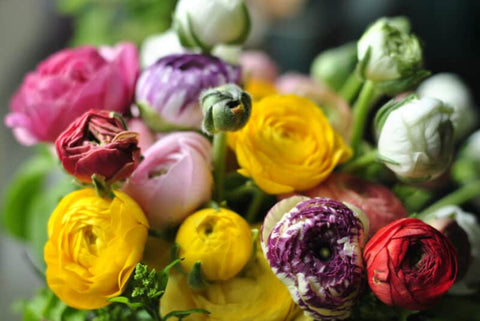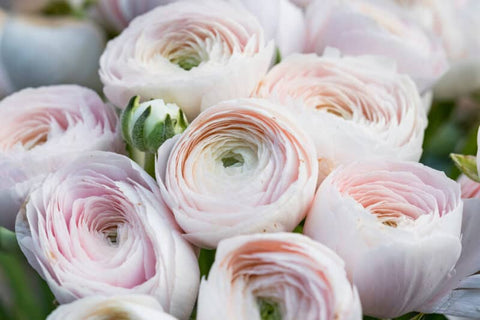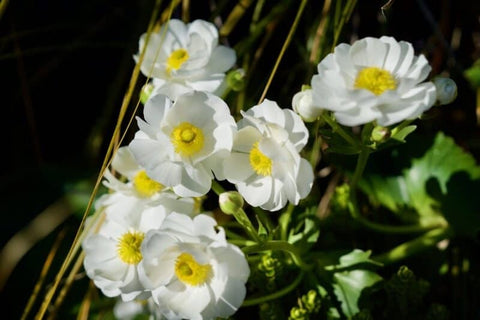Lately, people have fallen in love with ranunculus flowers, and the reasons are evident.
From single-petaled blooms to varieties with abundant petals, and from soft pinks to deep reds and purples, these seemingly delicate flowers have taken the gardening and flower farming world by storm.
Whether you dream of vases filled with frilly blossoms or wish to cultivate robust ground cover, you should give growing ranunculus a try.

Understanding Ranunculus
Ranunculus is a genus within the Ranunculaceae family, encompassing around 1800 species. These plants go by various names such as buttercups, water crowfoots, figworts, Persian buttercups, and spearworts.
Perhaps surprisingly, these plants are not just ornamental. While all ranunculus flowers are considered toxic when consumed, indigenous peoples of the Americas once used parts of these plants to treat bodily pains, skin ailments, and maladies.
Most ranunculus thrive in cool climates, meaning they like it chilly but not too cold. In most cases, they are grown from corms, which initially resemble octopuses, and can be propagated from seeds or division, depending on the variety.
Energy is stored in the roots and corms at the end of the season so they can resprout in the following year.
Seven Popular Varieties of Ranunculus to Grow
As we mentioned, there are numerous species, varieties, and hybrid ranunculus flowers to choose from, and listing them all would take all day. Let's explore some typically available and popular ranunculus flower varieties.
Persian Buttercup (Ranunculus asiaticus):

Native to the Mediterranean, southwest Asia, and southeastern Europe, Persian buttercup is one of the most recognized flowers in the ranunculus family. Commonly known as ranunculus, it's widely grown by florists, flower shops, and novice gardeners for cut flowers.
Double Blooming Persian Buttercup ('Tomer Picotee'): This is a highly unique variety of Persian buttercup with extremely thin, layered petals that resemble roses. It's a popular choice for wedding flowers. The blooms come in a range of vivid colors, including shades of white, pink, and purple with darker edges.
California's Tecolote Series: This series of Persian buttercup features double, peony-like blooms. Corms planted in the fall begin flowering in early spring, while those planted in late fall extend the bloom period into mid-spring. These flowers come in enchanting shades of pink, salmon, burgundy, yellow, and white.
'Amandine Rose': A smaller Persian buttercup variety with thin, layered petals growing on 10-15-inch stems. It has a longer and later flowering period due to its increased heat tolerance. Colors include various vibrant shades, including purple. It tolerates full or partial sun and is a perennial in USDA hardiness zones 7-11 but can be grown as an annual in zones 3-6.
Iceberg: This is the world's largest white clone of Persian buttercup, with 12-24-inch tall plants producing flowers with a 3-5 inch diameter. Each plant may produce 5-10 flowers at a time, blooming from spring into early summer. It has green basal leaves but may also have some leaves near the flowers. It can tolerate partial sun but prefers well-draining soil. Hardy in USDA zones 7-10 but can be grown as an annual in zones 3-6.
Early Buttercup: These small buttercups are among the first to bloom in spring, with bright yellow petals that almost look like they have a reflective coating due to the genus's glossy nature. They are a choice for ground cover, growing 4-12 inches tall. Once established, they can tolerate dry conditions and are suitable for rock gardens or smaller spaces. They propagate via tuberous roots and can self-seed if allowed to mature. Categorized as native wildflowers in dry prairies and open woodlands in the northeastern United States and Canada. They are cold-hardy and suitable for zones 3-7.
Mount Cook Buttercup (Ranunculus lyallii):

Known as the world's largest buttercup, this variety produces white flowers with a golden-yellow center. Native to the mountainous regions of New Zealand, it's cultivated globally as a perennial summer-flowering plant, even though it's not a true lily. It forms clumps, reaching 1-2 feet in width and 24-36 inches in height. It thrives in moist conditions and well-drained soil, making it less suitable for hot climates and potentially challenging for experienced gardeners. This is another cold-hardy variety, suitable for zones 3-11.
This is just a small selection of ranunculus flower varieties, but they're all known for their colorful blooms and unique characteristics. Whichever you choose, ranunculus flowers will add vibrant colors and diverse beauty to your garden.
How to Plant Ranunculus
Ranunculus can be grown from seeds or corms, and you can also purchase live plants from nurseries in the spring.
Growing from Seed
Plant seeds in pots with high-quality seed-starting mix and maintain soil moisture.
Germination typically takes around 20-30 days at temperatures around 50°F (10°C).
Protect seedlings from pests and direct sunlight.
Transplant seedlings outdoors after hardening them off.
Growing from Corms
Soak corms in room-temperature water.
You can either pre-sprout corms or plant them directly. Pre-sprouting helps identify viable corms.
Plant corms when it's cold but not freezing.
Protect emerging growth from extreme temperatures and pests.
Caring for Ranunculus
Most ranunculus varieties require full sun to bloom, although some can tolerate partial shade.
Keep the soil consistently moist but not waterlogged.
Use compost at planting and apply a balanced fertilizer monthly.
Be cautious, as all ranunculus types are toxic if ingested.
In regions with frost, dig up corms before the first frost.
Companion Plants
Marigold
Larkspur
Delphinium
Iris
Snapdragon
Foxglove
Sweet Pea
Iceland Poppy
Pansies
Candytuft
African Daisy
Pests, Problems, and Care
Protect corms from burrowing pests
Watch for aphids, thrips, mealybugs, nematodes, and spider mites.
Address pest issues promptly.
Prevent root rot by ensuring good drainage.
Ranunculus can be susceptible to powdery mildew and other fungal diseases.
In conclusion, ranunculus flowers offer diversity and beauty to any garden. By understanding their unique care requirements, you can create a stunning ranunculus landscape in your garden. Happy gardening!









